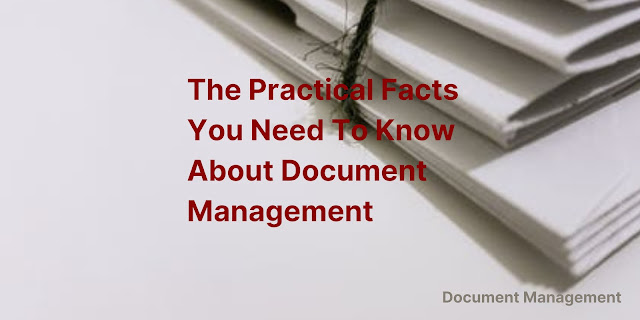Search This Blog

We help service enterprises in their growth phase with their organizational systems through focused coaching and consulting services on the following systems: leadership, communication, planning, resource management, operations, improvement & innovation, performance management, documentation, and risk management.
Featured
- Get link
- X
- Other Apps
The Practical Facts You Need to Know About Document Management
Documents. Paper documents.
We never seem to run out of paper documents.
The first document we ever held was probably a finger painting of our mom and dad or our pet. Before we even finish school for summer, we probably have a thick folder of school work to take home.And it’s just the beginning.
The Truth About Being Buried in Paperwork
The expression I’m buried in paperwork may turn out to be not an idiomatic expression at all. And what we dread the most about being buried in paper turns out to be our worst nightmares.
We get to college and we repeat the whole process with essays, reading reports, thesis, research, tables, charts, and an endless loop of piles of paper in a folder here, a box of folders there, and before we know it, we have succumbed to the inevitability of piles of documents on our desks.
You dump piles of paper on your desk. You dump more paper on your office mate’s desk. Then he returns the favor and dumps a lot more than yours on your deskIt’s like Friday the 13th The Movie, with someone just mysteriously coming in and adding more piles of documents and coming in next week for a sequel. And you attempt to organize the most confidential or more important documents in cabinets.
You’re starting to get mature now.
You actually arrange them in neat little stacks.
Then you run out of cabinets and just chunk them underneath tables, on top of computers, on desk corners, and more underneath. Your filling every space leaves only some room to allow you to wiggle your toe.
And then some smart guy comes along and suggests using binders like two-ring binders, three-ring binders, and then inserting them into more cabinets.
More cabinets. More desktops and corners. More corners and desktops. Chunk them into shelves. Chunk them to more shelves until the only options left are vertical or horizontal.
I’m not pointing fingers as to who started all these piles of documents. Most of it probably was there even before you started working in your job right now.
And it's not unique to your situation.
This is What Happens If We Eliminate the Mammoth Paperwork
Let me give you some numbers about paper documents worldwide. Let's run through some statistics on Paper Consumption in the Office.
According to Record Nations, the average office worker uses 10,000 sheets of copy paper each year. About 45% of this paper printed in offices will end up in the trash by the end of the day.
About $120 billion a year are spent on printed forms by corporations. Most of these forms outdate themselves within three months’ time. A typical employee spends 30-40% of their time looking for information kept in filing cabinets.
A four-drawer file cabinet has a capacity to hold an average of 10,000 to 12,000 documents, takes up about nine square feet of floor space, and costs around $1,500 per year.
More than 70% of businesses would fail within 3 weeks if they suffered a catastrophic loss of paper-based records due to fire or flood. The average paper consumption of businesses grows by around 22% per year, meaning in 3.3 years you can expect your paper consumption to double.
Record Nations offers storage and scanning solutions for regional and national companies around the US.Of course, we all wish it could be better. That’s a dream. No, this is our greatest dream.
We imagine a hallway with a neatly labeled stack of folders and envelopes stacked in expandable shelves. Neat stacks of document boxes or magazine holders arranged on high shelves.
I used to work for a business process outsourcing company that has an expanding row of shelves just keeping records of employees. We have several thousands of employees at any given time.
Once they marked folders for archiving it was my job to put them in storage, label them, and enter them into our database of archived documents. I can track all documents that went into the archive from which building, which room, which cabinet, which shelf, and to which file holder it is entered.
It was a simple document management system. Unfortunately, it was only my department tracking them. It was a document management system, its sole purpose is just for aging and for disposal after the storage date expires.
The Monumental Need To Document
There are many reasons why we need to document things. In most cases they fall under the following general reasons:
- The law requires it.
- We need evidence of facts.
- We need to track changes.
- We need to have a history of results.
- We need to know the “how” of things.
- Goals and plans
- Key processes Inputs to our key processes Outputs or results of our key processes Improvements or changes in any of the above
- We commonly document things via the following:
- Handwriting
- Images (photos, videos & drawings)
- Sounds or Audio
- Text (electronic or print)
The Interesting and Informative History of Something Uncommonly
Our experience with documents started when we invented writing. Writing was theorized to have been invented in a single civilization, a theory commonly referred to as "monogenesis".
Many Scholars subscribe to a belief that all writing originated in ancient Sumer (in Mesopotamia) and from there spread over the world via a process of cultural diffusion.
According to this theory, the concept of representing language by written marks was passed on by traders or merchants traveling between geographical regions. This concept, however, does not necessarily explain the specifics of how such a system worked.
The discovery of the scripts of ancient Mesoamerica, far away from Middle Eastern sources, however, proved that writing had been invented more than once.
Writing as many scholars now believe may have independently developed in at least four ancient civilizations: Mesopotamia (around 3400 and 3100 BC), Egypt (in 3250 BC), China (2000 BC), and lowland portions of Guatemala and Southern Mexico (by 500 BC).
I think you already know that the first images we have created were in caves then we evolved into visual art, photography, film, and then eventually to digital videos, together with that is the evolution of sound or audio technologies and then electronic data.
How do we assign names to documents and label them?
Here's how....
Using an Indexing System
An example of an indexing system is the Dewey Decimal System.
If you have been given a tour of a school library, the librarian will never skip giving you an orientation on the Dewey Decimal System and the index card to locate any book in the library.
Another example is the United States Army military personnel file referred to as 201 files. Later on, this system of filing was adopted by large corporations to keep track of workers.
The 201 file of the United States Army is a set of documents maintained by the US government for members of the United States armed forces.A 201 file contains a set of documents describing the member's military and civilian education history. This personnel file contains personal information such as the home of record, and awards documents.
Another example of an indexing system is the Chart of Accounts that keeps track of all ledgers of the accounting system in a uniform set of account titles as practiced by any country’s certified public accountants.
There are two versions: the chart of accounts for business enterprises and a chart of accounts for government accounting and audit.
Using a file naming convention
The concept of file naming conventions became popular during the introduction of the IBM Disk Operating System.
At that time, Microsoft was a sub-contractor of IBM developing the operating system for IBM Personal Computers or IBM-PC. Microsoft developed what came to be known as IBM PC-DOS. Microsoft came up with a set of rules on how to name electronic files.
At that time, you can only name files using eight characters. A highly limiting characteristic of naming files. They referred to it as 8.3 filenames.The file naming format of 8.3 has a maximum number of eight characters, optionally followed by a period “.” and a filename extension of at most three characters. Today, most Windows applications accept a filename up to 260 characters.
Using an automated numbering system.
Automated numbering systems are usually deployed to keep track of documents passing from one process or department to another. Today you usually hear this numbering system as a QR code.
The Quick Response code more popularly recognized as QR code is a type of matrix barcode (or two-dimensional barcode) first designed in 1994 for the automotive industry.Today, it is used as a contactless payment method where payment is performed by scanning a QR code from a mobile app or as a package tracker for the logistics industry.
Using a document management system.
A document management system is like using several technologies in one system. Usually, it involves scanning, file naming, automated numbering and indexing, and digital storage. It is basically all the technologies previously mentioned operated under one application or one piece of equipment.
Creating you own file name or label.
This last option naming or labeling files simply means, you do your own thing. You make anything, give it any name, and put it anywhere.
Now, how do we track documents?
We generally remember, retrieve, locate or link files using the following sets of data:- File names (What is the name it currently carries? What file name will we see when we look at the folder or holder of the document?)
- Holder names (What is the container? or Who currently has custodial or physical possession of the document?)
- Owner or Creator (Who created or who made the last modification to the document?)
- Date of Creation (When was it created?)
- Contents or Purpose (Why does that document exist? Or What was the reason it was created?)
- Storage or Physical Location (Where is it now physically? Or Where is it stored virtually or digitally?)
Document Management becomes critical after your enterprise starts to evolve into its growth phase. You start losing track of operations, project details or even losing physical or digital files. Retrieving customer information starts to get challenging. I can help you map your document management or file management system. Shoot me an email: vyparalisan@virgilioparalisan.com.
If you have learned something or anything in my post, please give me feedback on exactly how it helped you or give me a review by going to this page now!
Popular Posts
Using Value Proposition Canvas For Surprisingly Awesome Products And Services
- Get link
- X
- Other Apps
The Six Elements of Communication You Need To Exploit For Awesome Results
- Get link
- X
- Other Apps











Comments
Post a Comment